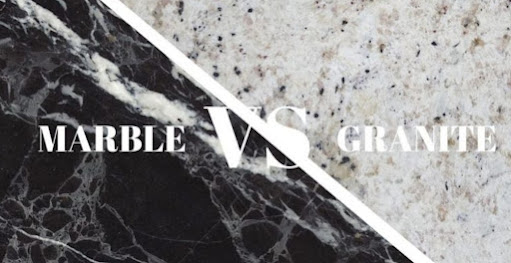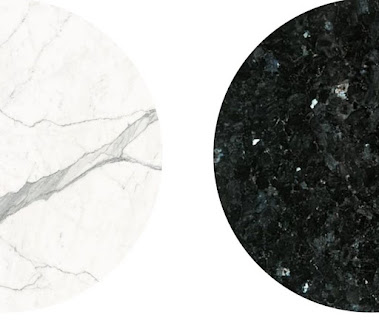Search This Blog
RK Marbles USA is a leading natural stone company with a wide selection of affordable services and high quality products for residential and commercial projects. Our company offers a variety of colors and designs to suit the needs of your home.
Featured
- Get link
- X
- Other Apps
The Essential Guide : Choosing Between Granite v/s Marble
Granite v/s Marble? Which is more suitable for kitchen countertops, floors and bathrooms?
The "granite v/s marble" conundrum is one of the topics we get asked the most. Which one is most suitable for each project and what are their similarities and differences?
The quick answer is that marble and granite are both valuable natural stones with unique aesthetic qualities and many structural benefits that make them dependable and wildly popular with builders, architects, and decorators. But before we respond to the question "marble vs. granite," let's take a closer look at their traits.
What is granite and marble, and how are they made?
Natural processes taking place deep within the earth's crust give rise to both granite and marble.
How does granite form, and what is it made of?
The igneous rock known as granite has light-colored granules large enough to be seen with the unaided eye. Granite is mostly composed of quartz and feldspar, with trace amounts of mica and other minerals, and develops when magma deep below the earth slowly crystallises. Due to its attractiveness and durability over time, it is frequently chosen by decorators and architects.
How does marble form, and what is it made of?
Marble, on the other hand, is a metamorphic rock that develops when limestone is exposed to extreme pressure and heat conditions. During the transformation process, the calcite present in the limestone recrystallizes, altering the structure and form of the natural stone. With its variety making it perfect for flooring, bathrooms and bathroom vanities, fireplaces, kitchen counters, wall coverings, etc., marble is without a doubt the most magnificent and opulent material among all natural stones.
How do marble and granite differ from one another?
There are a number of similarities and distinctions between marble and granite. Since they are actual, natural stones, their similarities and differences are a result of how they were made, which naturally affects how and how they are applied in diverse projects.
What are the benefits and drawbacks of granite v/s marble?
Let's examine each of their fundamental qualities individually before getting more precise by weighing the advantages and disadvantages of each natural stone.
Granite and marble "appearance"
The extraordinary beauty and uniqueness of the two materials are both advantages. After all, there are seldom two slabs of stone that look exactly alike when we talk about truly natural stone. Granite and marble slabs differ greatly from one another in this way. Since no pattern repeats itself anywhere, marble slabs are particularly distinctive in this regard. Granite has a distinctive speckled pattern and typically has a glossy polished surface. In contrast, marble typically has veins running across its surfaces because of its metamorphic characteristics, which produce designs that can go with any installation.
Granite and marble come in a variety of colours.
No matter the aesthetic of your project, you will be able to locate the perfect material because the appearance and colour of each slab differ depending on the two stones' mining regions. Since black and dark grey are the most popular granite colours , these materials are perfect for high-end granite constructions like fireplaces and bathrooms. The majestic green or dark stones that give every area a sense of wealth, as well as the pure white or cream marbles, are largely responsible for the attractive appearances of marble colors . Compared to granite, marble comes in a far wider range of colours.
Granite v/s Marble's tensile strength
When maintained properly, both marble and granite offer excellent durability and lifespan. Even though they were formerly viewed by many as being only suitable for projects with less traffic, equally durable marbles are now often used in heavy traffic projects. However, it is important to consider the technical properties of the material that best satisfies the project's needs while choosing the ideal marble. To choose the ideal decision, we need consider factors like absorbency, resistance to abrasion, pressure, and frost.
Granite v/s Marble that resist heat.
Granite v/s marble both behave similarly in terms of heat resistance. Despite the materials' excellent resistance to high temperatures, it is advised against applying excessive heat to their surface. The use of trivets or hot pads will protect the surface and increase its lifespan. Placing hot pans and cookware directly on surfaces is not advised.
Granite v/s marble are both scratch- and stain-resistant, and they require minimal care.
Both marble and granite are susceptible to liquid stains because of their porous surfaces. When in contact with sharp objects that could scrape and gouge its surface, marble should be handled with more care than granite. Natural stone must be carefully maintained with the right sealing and insulating products to maximiser their inherent durability in order to prevent stains and scratches. There is, regrettably, no process that an accident cannot be reversed. To ensure that your marble or granite lasts a long time, however, proper care and maintenance must be taken.
What applications does granite have?
Granite is a popular material for construction and decoration due to its natural beauty, resistance to abrasion and corrosion, ability to support great weight, and other properties. For thousands of years, it has been one of the most widely used materials, and we frequently see it in urban settings, whether for large-scale construction projects like bridges, buildings, and monuments, or interior projects like tiles, kitchen countertops, baths, and kitchen backsplashes.
What applications does marble have?
Applications for marble's special qualities can be found in pharmaceuticals, agriculture, painting, sculpture, and even architecture. Because of its elegant and pristine appearance, which emits light and richness, marble is used extensively in interior applications. Marble is used for a variety of things, including floor tiles, wall cladding, countertops, baths, fireplaces, interior columns, staircases, furniture, and accessories.
Granite v/s marble? Which is better for flooring, bathrooms, and kitchen countertops?
Bathrooms, flooring, and worktops made of marble and granite are some of the most common interior applications for these materials. With proper maintenance and sealing to prevent damage and stains from heat, acidic substances, and sharp surfaces, both marble and granite display exceptional resistance and durability over time. The choice relies on the aesthetic result you want to attain despite the fact that both stones are undeniably beautiful.
Conclusion :
Both marble and granite have an endless array of colours, textures, and aesthetic appeal. You can even break the rules and combine various natural stone varieties to produce stunning, one-of-a-kind rooms. In the end, what counts is that you select the natural stone that speaks to you and will turn your house into a home.
R.K Marbles USA is a renowned granite v/s marble exporter in the USA. We offer a wide range of natural stones with assured quality and the best price in the market.
For more information regarding any other natural stone, contact- +91-9928979999
Popular Posts
Marble Coffee Table: Why You Should Choose Marble For Your Home
- Get link
- X
- Other Apps







Comments
Post a Comment